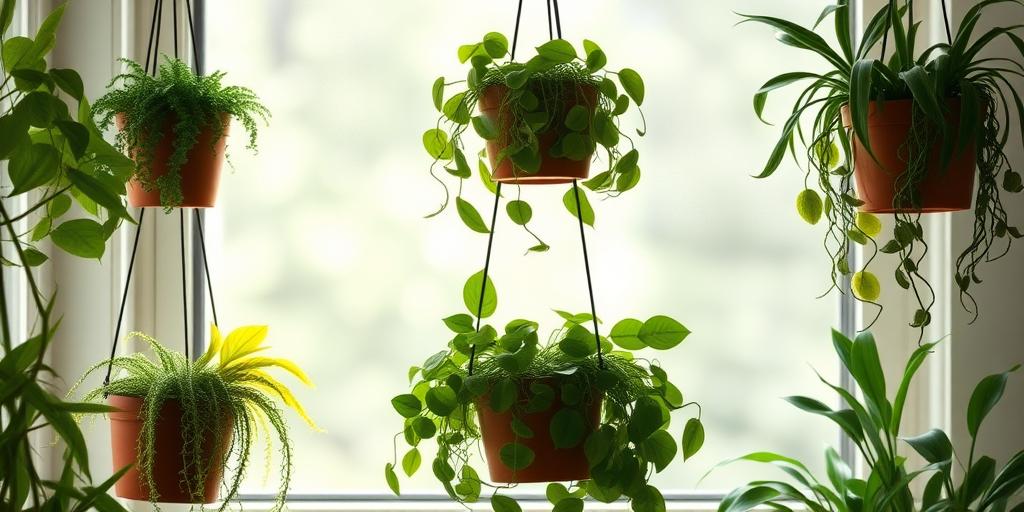
10 Pet-Friendly, Low-Light Hanging Plants for a Safe Home (2025)
Discover 10 beautiful pet-friendly, low-light hanging plants perfect for your home! Keep your space green and safe for furry friends with these easy-care options.
Introduction
Did you know that over 65% of pet owners worry about toxic plants in their homes? If you’re a plant lover with pets, finding safe, low-maintenance hanging plants can be tricky—but not impossible! Whether your home lacks bright sunlight or you want to avoid toxic foliage, this guide has you covered. We’ve curated 10 pet-friendly, low-light hanging plants that thrive indoors while keeping your cats and dogs safe. Let’s dive in!
Why Choose Pet-Friendly, Low-Light Hanging Plants?
If you’re a plant lover with pets or limited natural light, pet-safe hanging plants are a game-changer. Not only do they add greenery without taking up floor space, but they also keep your furry friends safe. Many common houseplants can be toxic to pets, so choosing non-toxic varieties ensures peace of mind. Plus, low-light plants are perfect for apartments or rooms with few windows, making them ideal for urban living.
Benefits of Hanging Plants in Small Spaces
Hanging plants maximize vertical space, which is especially helpful in tight living areas. They can soften corners, add visual interest, and even improve air quality. Since they’re elevated, they’re less likely to be knocked over by curious pets—though some cats might still see them as a challenge!
Risks of Toxic Plants for Pets
Many popular houseplants, like pothos, philodendrons, and peace lilies, can be harmful to pets if ingested. Symptoms of poisoning include vomiting, drooling, or lethargy. By sticking to pet-safe options, you eliminate this risk while still enjoying lush greenery.
How Low-Light Plants Adapt to Indoor Conditions
Low-light plants have evolved to thrive under forest canopies, meaning they don’t need direct sunlight to grow. They often have larger, darker leaves to absorb more light efficiently. This makes them perfect for dimmer corners of your home where other plants might struggle.
Top 10 Pet-Safe, Low-Light Hanging Plants
1. Spider Plant (Chlorophytum comosum)
Spider plants are a classic choice for pet owners. They’re completely non-toxic to cats and dogs, and their long, arching leaves look stunning in hanging baskets. They thrive in indirect light and are incredibly forgiving—perfect for beginners. Plus, they produce “pups” (baby spider plants) that you can easily propagate and share with friends.
2. Boston Fern (Nephrolepis exaltata)
With its lush, cascading fronds, the Boston fern adds a touch of jungle vibes to any space. It prefers humid environments, making it great for bathrooms or kitchens. Not only is it safe for pets, but it also acts as a natural air purifier. Just keep the soil consistently moist to keep it happy.
3. Staghorn Fern (Platycerium bifurcatum)
This fern stands out with its unique, antler-like leaves. It’s low-light tolerant and pet-friendly, though it does appreciate occasional misting. Mount it on a wooden board or place it in a hanging basket for a dramatic, eye-catching display.
4. Peperomia (Peperomia spp.)
Peperomias come in many shapes and sizes, with some varieties trailing beautifully. They’re completely safe for pets and do well in moderate to low light. Their thick leaves store water, making them relatively drought-tolerant—ideal for forgetful waterers.
5. Swedish Ivy (Plectranthus verticillatus)
Despite its name, Swedish Ivy isn’t a true ivy (which can be toxic). It’s fast-growing, pet-safe, and thrives in shade, making it perfect for dimmer rooms. Its scalloped leaves spill gracefully over the edges of hanging planters.
6. Baby’s Tears (Soleirolia soleirolii)
This delicate plant forms a dense mat of tiny, round leaves that cascade beautifully. It loves humidity and low light, making it great for terrariums or bathrooms. Since it’s non-toxic, you won’t have to worry if your pet takes a curious nibble.
7. Burro’s Tail (Sedum morganianum)
A succulent with trailing stems covered in plump leaves, Burro’s Tail is safe for pets—though its fragile leaves can drop easily if disturbed. It prefers bright indirect light but can tolerate lower light. Just be cautious with placement if you have a playful cat!
8. Prayer Plant (Maranta leuconeura)
Known for its striking patterned leaves that move with the light, the Prayer Plant is pet-friendly and loves humidity. It does well in low to medium light, making it a great choice for bedrooms or offices.
9. Friendship Plant (Pilea involucrata)
This plant has textured, crinkled leaves with a unique appearance. It’s safe for pets and thrives in filtered light. Its compact size makes it perfect for small hanging pots or mixed planters.
10. String of Hearts (Ceropegia woodii)
With its delicate, heart-shaped leaves on trailing vines, this plant is a favorite for hanging displays. It’s non-toxic to pets and can adapt to lower light, though it grows faster with brighter indirect light.
Caring for Your Pet-Friendly Hanging Plants
Watering Tips for Low-Light Plants
Since low-light plants grow slower, they generally need less water. Always check the soil before watering—stick your finger in about an inch deep. If it’s dry, it’s time to water. Overwatering is a common issue, so err on the side of caution.
Best Soil and Potting Mixes
A well-draining mix is key to preventing root rot. For most hanging plants, a standard indoor potting mix with added perlite or orchid bark works well. Succulents like Burro’s Tail need a grittier mix to avoid excess moisture.
How to Prevent Pests Naturally
Keep an eye out for pests like spider mites or aphids. Regularly wiping leaves with a damp cloth helps. For a natural pest deterrent, try neem oil or a mild soap-water spray.
When and How to Fertilize
Fertilize sparingly during the growing season (spring and summer) with a diluted, balanced fertilizer. Low-light plants don’t need much, so once a month is usually sufficient.
Where to Hang Your Plants for Optimal Growth
Best Spots in Low-Light Homes
North-facing windows or spots a few feet away from east/west windows are ideal. Hallways, bathrooms, and shaded corners can also work well.
Avoiding Drafts and Extreme Temperatures
Keep plants away from air vents, radiators, or drafty windows, as sudden temperature changes can stress them.
Creative Hanging Ideas
Macramé hangers add a boho touch, while wall-mounted shelves or ceiling hooks can create a cascading green display. Mix and match different planters for visual interest.
Common Pet-Plant Safety FAQs
What to Do If Your Pet Eats a Plant
First, identify the plant. If it’s toxic, contact your vet or the ASPCA Animal Poison Control Center immediately. Even with non-toxic plants, monitor for any unusual behavior.
Signs of Plant Toxicity in Pets
Symptoms include vomiting, diarrhea, drooling, or lethargy. If you notice these, seek veterinary advice right away.
Pet-Friendly Alternatives to Toxic Plants
Replace toxic favorites like pothos with safe options like spider plants or peperomias. Always double-check the ASPCA’s list of non-toxic plants before buying.
Conclusion
Adding greenery to your home doesn’t have to be risky for your pets! With these 10 pet-friendly, low-light hanging plants, you can create a lush, safe oasis for both your plants and furry friends. Ready to transform your space? Pick your favorites and start hanging today!
